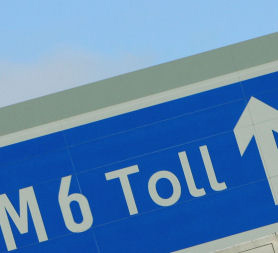Motorway tolls ‘not a solution’ to traffic congestion
Private toll roads are not cost effective, do not help congestion in their immediate area, do not reduce journey times and give investors a poor return, a report has claimed.

The transport pressure group Campaign for Better Transport analysed the M6 Toll road in the West Midlands.
The road is the UK’s only private motorway which opened in 2003 and runs 27 miles around the northwest of Birmingham between the junction 3a and Junction 12 of the M6.
The Campaign for Better Transport said despite early promises to give drivers faster, more reliable journey times, travel durations are only marginally quicker than those of seven years ago.
The report claimed drivers who use the M6 Toll road – and pay £5 per trip – are not getting value for money.
It said the motorway is being used by fewer motorists than envisaged either because of the cost or because of the recession, arguing there were 60,000 drivers a day in 2006 compared with just over 40,000 by the start of this year.
The report highlighted plans by the Highways Agency to spend a further £500m trying to relieve existing congestion on the M6, congestion that it said the toll road was supposed to alleviate.
“Toll roads are not, and will never be, a solution to congestion on Britain’s roads, no matter how attractive they may appear to cash-strapped politicians desperate to deliver otherwise unaffordable road schemes,” the report concluded.
The report’s authors used statistics from the Highways Agency, the Commons Transport Select Committee and the company that built and runs the road, Midland Expressway Limited (MEL).
Midland Expressway has not commented on the report.
The coalition government has suggested that future motorways in England may be built using private money.
However a Department for Transport spokesman said. “The construction of a privately funded and operated toll road was not the only answer to cutting congestion on the M6.
“While it is making a contribution, the Government is also considering other transport initiatives to ease congestion such as hard shoulder running schemes and the development of a national high-speed rail network with the first route running between London and the West Midlands.”